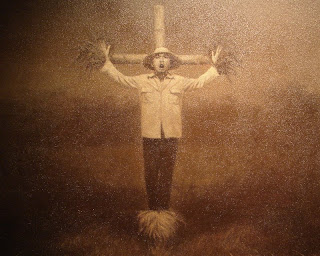Found this on the web:
El Mes Español — Without Spanish, What Is A Filipino?Friday, October 13th, 2006 in Jaded Fables, Culture by Pepe AlasA PILIPINO is convincing a FILIPINO to become patriotic…
PILIPINO: We must get rid of Spanish words from our native languages!
FILIPINO: And why is that?
PILIPINO: “Why” is a stupid question. Haven’t you learned anything from your history class? It is but a folly to retain Spanish loan words in our languages when it was Spain who destroyed our identity!!!

FILIPINO: Oh. Really.
PILIPINO: Really!!! And not only that! We should not cherish any Spanish legacy at all! Aside from Spanish tyranny, Spanish culture is not Philippine culture!
FILIPINO: Does that mean we have to throw away the culture that Spain bequeathed to us?
PILIPINO: Yes, of course! Don’t you remember what Señor Simoun told Basilio? “If they are unwilling to teach you their language, cultivate your own.” In a larger sense, we should cultivate our own culture.
FILIPINO: Hmmm, you have reason. So, throw everything away?
PILIPINO: EVERYTHING! The language, the culture, the concepts, the religious superstition… EVERYTHING!!! Our national heroes have already set an example by revolting against Spanish tyranny! Leadership by example! We should follow the great Filipinos of yore!
FILIPINO: Oh, OK. I might agree. But first, you have to begin this Castilian purging from our “culture” yourself. Just like what you said, “leadership by example…”
PILIPINO: Exactly. I’d be happy to take the lead. Now, what do you want me to do?
FILIPINO: First of all, take off your sombrero my friend. It’s Spanish.
PILIPINO: (stumped). That would be easy.
FILIPINO: And throw away that corbata, too. Of course you know it’s Spanish.
PILIPINO: (thinking) Well… I think I’d still look fine without a tie.
FILIPINO: And your passionate “nationalism” would look good on you if you take off your chaleco, camisa, vestido, zapatos, cinturón, and pantalón as well.
PILIPINO: Now wait a minute there…!
FILIPINO: No, you wait a minute there!!! You’re PILIPINIZATION is not yet reflecting on you. You’re still wearing a relój.
PILIPINO: Fool! This wrist watch is from the US, not from Spain.
FILIPINO: You’re the one who’s loco, ese. We’re not talking about brand names. It doesn’t matter if you’re wearing GUESS? or HILFIGER or whatever stuff that came out from another country that is not Spain. We’re not only talking about Spanish words now but concepts also. Before the arrival here of ROLEX and SWATCH and TIMEX, Filipinos already have watches and large grandfather clocks. Of course you already know that.
PILIPINO: (hesitant) Oh, all right! (mumbles and grumbles, but throws watch away) There! Gone!
FILIPINO: You can always tell the time by just looking at the sun, moon, and the stars, right! That’s the true PILIPINO way! Cultivate our own!
PILIPINO: (sigh of exhaustion) Cultivate our own…
FILIPINO: Uh, sir. you still have your medias and calzoncillo on…
PILIPINO: (raising his voice) Are you mad?!
FILIPINO: Nope. But I think you are if you’re still donning Spanish concepts. Leadership by example?
PILIPINO: (groans)
FILIPINO: Don’t worry! You can always search our forests –or whatever the neocolonizers might have left of it– for tree barks and any natural material for your clothing. Now that’s true PILIPINO culture. Am I right? Or am I right?
PILIPINO: …
FILIPINO: Good! Leadership by example.
PILIPINO: Leadership by example.
FILIPINO: Cultivate our own?
PILIPINO: Cultivate…
FILIPINO: (inspects PILIPINO) Say, you’ve got false teeth.
PILIPINO: (embarrased) Yeah, so what?

FILIPINO: Throw that postizo away, dude. That’s demeaning to our “true” culture. But let’s save your peluca just for this month’s Halloween party.
PILIPINO: Egad…
FILIPINO: Here, wear these in the meantime so you won’t grow cold (hands over strips of banana leaves for the PILIPINO to wear).
PILIPINO: Are you doing this to mortify me?
FILIPINO: How ’bout saying “thank you for giving me something to wear” instead?
PILIPINO: (grumpy) Thank You!!!
FILIPINO: You’re very much welcome. Now where were we? Oh, yes, and don’t use all utensils that the Spaniards brought here.
PILIPINO: ?
FILIPINO: OK. Let me make it clearer. “Throw everything away?” That’s perhaps the most patriotic idea I’ve ever heard in my life. Friend, dispose of your cubiertos, aparador, cama, silla, balde, pozo, lápiz, papel, plato, cepillo, florera, la mesa, ventilador, todo todo TODO! And do I even have to mention the food?
PILIPINO: Friend, I think you should…
FILIPINO: Go on? By all means. Don’t even think of continuing your educación. Those libros at school will poison your mind. Stop going to church, too. Remember how María Clara was screwed! And your ancestral home, man, your bahay na bató is getting to be an eyesore. Better demolish it.
PILIPINO: (panting) That house is my family’s house! It is the history and the soul of my family and ancestors!!!
FILIPINO: Which is, unforunately, español. Enough talk. I’m your convert, dude. You woke me up from the “bitter” truth. You make me proud! And without anything to wear now except for those leaves, sonuvagun, you look very fine! Very respectable! Very great when you’re naked, y’know. Very PILIPINO.
PILIPINO: Oh please stop…
FILIPINO: Indeed, without Spanish, our “true” identity will emerge. Thank you, friend, for this “awakening.”











